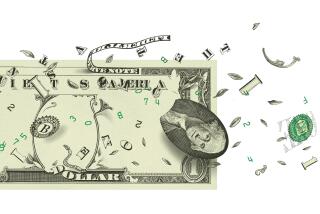Market Investors: Are You Ready to Face Bear Facts?
- Share via
So Barton Biggs, the seemingly eternally grumpy investment strategist at Morgan Stanley, Dean Witter in New York, believes that a bear market is all but inevitable on Wall Street in 1998.
His prediction, issued last week, helped pull the Dow Jones industrial average down 110.91 points Thursday, and probably was at least partly responsible for the Dow’s dive on Friday morning, when it lost 269 points--before rebounding spectacularly in the afternoon to close off 90.21 points at 7,756.29.
Biggs may well be right about 1998. He certainly must be hoping that he’ll have better luck calling the U.S. market than he did calling the Asian situation. In March of this year he was still assuring clients that “the ‘Asian Way’ is for real,” referring to the region’s so-called economic miracle.
And neither Thailand nor South Korea “is a Mexico in the making,” Biggs maintained in March, referring to Mexico’s economic and market debacle in 1995.
No, Thailand and South Korea aren’t Mexico--they’re worse, at least in terms of how far their stock markets have fallen this year (50% plus) compared with the Mexican market’s decline in 1994-95.
Well, you win some and you lose some in this business, as yours truly knows all too well.
Market prognosticators generally do not throw stones at one another because we all live in glass houses on the same cul-de-sac. So Biggs is entitled to his opinion, and his clients are entitled to pay him a lot of money to hear that opinion.
But just because Biggs and some of his high-profile Wall Street peers (like the previously wildly bullish Ralph Acampora of Prudential Securities) now predict a bear market in ’98 doesn’t mean it will happen. They don’t necessarily have any better idea of what the market will do than the novice investor with a few hundred dollars in a mutual fund.
Perhaps the greatest danger for individual investors is simply the potential to be psyched out by the term “bear market,” which probably sounds all the more ominous to many people because the last bear phase in stocks occurred so long ago, in 1990.
Indeed, most of the money in stocks today arrived after the last bear decline, so many investors have no frame of reference.
*
What kind of images does a bear market prediction conjure up? Recession? Depression? Brokers jumping from tall buildings? Christmas canceled?
Rising stock prices naturally are more fun than falling stock prices, but the fact is that bear markets have occurred with relative frequency for as long as there has been a stock market.
A bear market decline is usually defined as a drop of 20% or more, from peak to trough, in major stock indexes such as the Dow industrials and the Standard & Poor’s 500.
There have been nine such declines in the S&P; 500 in the post-World War II era. And miraculously, civilization has survived them all. The market always came back, because the U.S. economy has continued to advance.
Painful as they may be, bear markets tend to be over quickly, while bull markets tend to be far longer in duration. The average length of postwar bear markets is eight months. Gravity, it seems, works in the stock market as in real life: It takes a long time to push a boulder up a hill, but not very long to roll it down.
Some bear markets, however, have been incredibly brutal on investors. The worst of the postwar era occurred in 1973-74, when blue-chip stock indexes lost about half their value over a grueling 21-month period that witnessed soaring oil prices, sharply higher inflation and interest rates, and President Nixon’s resignation, among other nightmares.
Could a bear market of that magnitude be triggered today? Not by inflation, apparently, because that worry is virtually nonexistent. And U.S. interest rates are declining, not rising.
For Biggs and many other stock strategists, the great risk to the 7-year-old bull market now is deflation--specifically, deflation of corporate profit growth from the heady gains of the past five years, which have been critical in supporting ever-rising stock prices.
“I think investors in the West are grossly underestimating the recessionary and disinflationary-deflationary forces of what is happening in Asia,” Biggs says.
Asia’s unwanted gifts to the business world, in the wake of the region’s devalued currencies and devastated financial markets, will be slower world economic growth in 1998 and severe export price competition, Biggs says. That, in turn, will at best mean no overall earnings growth for the S&P; 500 blue-chip companies, and perhaps a 5% to 10% decline in earnings compared with 1997, he says. In any case, he sees earnings disappointments being enough to demoralize investors and bring on the bear.
Recent downbeat profit forecasts from such companies as 3M Co., Nike Inc. and software leader Oracle Corp. would seem to strengthen Biggs’ case. But like circus performers plunging from a high-wire act, these companies are getting the crowd’s undivided attention right now. By contrast, the many companies still successfully walking the wire (i.e., meeting earnings expectations) tend to be ignored at a time like this.
Within the elite group of Wall Street strategists whose words can sway big investors, Biggs’ polar opposite is Abby J. Cohen of Goldman, Sachs & Co. Her 1998 market forecast is for slowing corporate earnings growth, but no implosion. Given the still-healthy U.S. economy, she figures blue-chip companies can boost profits 8%, on average, next year versus 1997--enough to produce a 10% or so gain in stock prices by the end of 1998.
*
Should Cohen’s bullish forecast carry more weight than Biggs’ bearish one? The major risk for individual investors in paying too much attention to any such short-term market forecasts is that they can cause you to lose sight of your long-term investment goals.
Another bear market will arrive some day, maybe sooner than later, as Biggs believes. Stock prices will decline sharply, much more than the 6% drop the Dow index has already realized from its Aug. 6 record high to now.
But chances are very good that, unless you expect global economic calamity, the bear market will run its course in relatively short time, and stock prices will begin to rise again. If you’re truly a long-term investor, and you bail out now, will you know when to get back in? Will Barton Biggs accurately call the reentry point for you?
If you can’t stand the thought of temporarily losing 20% to 30% or even more of your equity investment, the best advice may be Biggs’, after all: The headline on his market forecast letter last week was “Sell Down to the Sleeping Point.” In other words, have only as much in the market as will allow you to sleep comfortably at night, regardless of what happens next.
Tom Petruno can be reached at [email protected]
More to Read
Inside the business of entertainment
The Wide Shot brings you news, analysis and insights on everything from streaming wars to production — and what it all means for the future.
You may occasionally receive promotional content from the Los Angeles Times.










